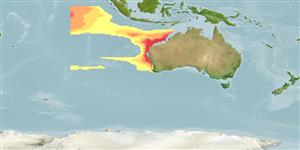Elasmobranchii (haaien en roggen) (sharks and rays) >
Squaliformes (Sleeper and dogfish sharks) >
Squalidae (Dogfish sharks)
Etymology: Squalus: Genus name from Latin 'squalus' meaning shark (Ref. 6885, 27436); crassispinus: Name from Latin 'crassus' meaning fat or stout and 'spinus' for thorn, referring to the unusually stout dorsal-fin spines (Ref. 58437).
More on authors: Last, Edmunds & Yearsley.
Environment: milieu / climate zone / depth range / distribution range
Ecologie
marien; diepte 187 - 262 m (Ref. 58437). Subtropical
Eastern Indian Ocean: northwestern Australia; probably occurs more widely in the eastern Indian Ocean.
Grootte / Gewicht / Leeftijd
Maturity: Lm ? range ? - ? cm
Max length : 47.6 cm TL mannelijk / geslacht onbekend; (Ref. 58437); 58.0 cm TL (female)
Korte beschrijving
Morfologie | Morfometrie
This small species of the 'megalops-cubensis group' is distinguished by the following characters: head width at mouth 9.9-11.3% TL; mouth width 2.1-2.4 times the horizontal prenarial length; direct pre-second dorsal length 3.7-4.2 times the pectoral-fin anterior margin, 2.6-2.8 times the dorsal caudal margin; preoral length 2.7-3.0 times the horizontal prenarial length, 8.3-9.2% TL; anterior nasal flap strongly bifurcate; first dorsal fin upright to raked; the exposed bases of dorsal-fin spines are very broad, 1.2-1.5% TL; both dorsal fins have short inner margins, first dorsal-fin height 1.3-1.7 times its inner margin length, second dorsal-fin height 1.1-1.3 times its inner margin length; pectoral-fin anterior margin 1.9-2.2 times its inner margin length; preventral caudal margin 2.4-4.6 times inner margin of pelvic fin; caudal fin pale with poorly demarcated, whitish posterior margin, caudal bar absent; flank denticles unicuspid; monospondylous centra 39-42 (mainly 40-41), precaudal centra 82-86, total centra 107-111 (mainly 109-110) (Ref. 58437).
Found at the lower continental shelf and upper continental slope (Ref. 58437).
Levenscyclus en paargedrag
Maturiteit | Voortplanting | Paaien | Eieren | Fecunditeit | Larven
Distinct pairing with embrace (Ref. 205).
Last, P.R., M. Edmunds and G.K. Yearsley, 2007. Squalus crassispinus sp. nov., a new spurdog of the 'megalops-cubensis' group' from the eastern Indian Ocean. p. 11-22. In P.R. Last, W.T. White and J.J. Pogonoski Descriptions of new dogfishes of the genus Squalus (Squaloidea:Squalidae). CSIRO Marine and Atmospheric Research Paper No. 014. 130 p. (Ref. 58437)
Status op de Rode Lijst van het IUCN (Ref. 130435)
Gevaar voor de mens
Harmless
Gebruik door de mens
Meer informatie
Leeftijd/GrootteGroeiLengte-gewichtLengte-lengteLengtefrequentiesMorfometrieMorfologieLarvenLarvale populatiedynamiekRekruteringAbundantieBRUVS
ReferentiesAquacultuurAquacultuurprofielKweeklijnenGeneticaElectrophoresesErfelijkheidZiektesVerwerkingNutrientsMassaconversie
Tools
Speciale rapporten
Download XML
Internetbronnen
Estimates based on models
Preferred temperature (Ref.
123201): 14 - 17.7, mean 16.5 °C (based on 9 cells).
Fylogenetische diversiteitsindex (Ref.
82804): PD
50 = 0.5000 [Uniqueness, from 0.5 = low to 2.0 = high].
Bayesian length-weight: a=0.00339 (0.00162 - 0.00707), b=3.10 (2.93 - 3.27), in cm total length, based on LWR estimates for this Genus-body shape (Ref.
93245).
Trofisch niveau (Ref.
69278): 4.2 ±0.3 se; based on size and trophs of closest relatives
Weerstandsvermogen (Ref.
120179): laag, minimale populatieverdubbelingstijd 4,5-14 jaar (Preliminary K or Fecundity.).
Fishing Vulnerability (Ref.
59153): Moderate vulnerability (43 of 100).
